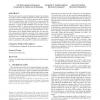Free Online Productivity Tools
i2Speak
i2Symbol
i2OCR
iTex2Img
iWeb2Print
iWeb2Shot
i2Type
iPdf2Split
iPdf2Merge
i2Bopomofo
i2Arabic
i2Style
i2Image
i2PDF
iLatex2Rtf
Sci2ools
IMC
2004
ACM
2004
ACM
Bandwidth estimation in broadband access networks
There has been much work on developing techniques for estimating the capacity and the available bandwidth of network paths based on end-point measurements. The focus has primarily been on settings where the constrained link can be modeled as a point-to-point link with a well-defined bandwidth, serving packets in FIFO order. In this paper, we point out that broadband access networks, such as cable modem and 802.11-based wireless networks, break this model in various ways. The constrained link could (a) employ mechanisms such as token bucket rate regulation, (b) schedule packets in a nonFIFO manner, and (c) support multiple distinct rates. We study how these characteristics impede the operation of the various existing methods and tools for capacity and available bandwidth estimation, and present a new available bandwidth estimation technique, ProbeGap, that overcomes some of these difficulties. Our evaluation is based on experiments with actual 802.11a and cable modem links. Categorie...
| Added | 30 Jun 2010 |
| Updated | 30 Jun 2010 |
| Type | Conference |
| Year | 2004 |
| Where | IMC |
| Authors | Karthik Lakshminarayanan, Venkata N. Padmanabhan, Jitendra Padhye |
Comments (0)

